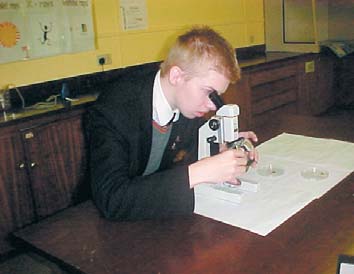| 2005 |

|
YEAR BOOK |
Abbey Grammar Christian Brothers School, Newry, Co. Down
|
Feeding behaviour in the freshwater Gammarus
|
A recent study has shown that Ireland's �streams have been overrun by invaders. The native shrimp, Gammarus duebeni, has been out-competed by the introduced Gammarus pulex. I believed an investigation into the feeding behaviour of this 'alien' species would provide an insight into the reason for this colonisation.
Upon collection, I separated the sample into four test groups; male, female, juvenile and 'amplexed-couple'. The 'amplexed-couple' is when a male holds the female during the precopulatory stage. I next placed each group in oxygenated aquaria of filtered water, 'starving' them for two weeks in order to catalyse experiments and eradicate all traces of material from the gut, ensuring accurate gut-content analysis. I found they swam on their sides for a short distance and sank to the base, displaying a benthological approach to feeding.
Prior to investigation I believed the shrimp were herbivores and thus presented each group with a selection of plant material. I found there was a significant preference for hawthorn leaves in males and ash in females. Juveniles displayed both adult preferences but the couple's choice was dictated by the female, showing a striking similarity to human nature by attempting to 'placate' the female!
I next presented them with macro-invertebrates from the stream. I found they displayed carnivorous tendencies but predation was size-dependent. I discovered past feeding behaviour influenced future preferences by rearing half of the juveniles on plant material and the remainder on animal. When given a choice they chose the new material, exhibiting a desire for a 'balanced diet'.
A common preconception was that the Gammarus were detritivores. I presented fresh and decomposed material, noticing a preference for the fresh. I discovered they resorted to cannibalism in order to survive but once again it was size-dependent. However the male in the amplexed-couple consumed his partner, who was previously dominant, rather than place himself at risk.

When plant material was placed in different coloured depots, I noticed there was a definite attraction to the orange depot, showing stimulus may have been visual as well as chemotaxis.
In conclusion the Gammarus pulex could be placed in several functional feeding groups. It is a definite omnivore but if given a choice, not a detritivore and if the worst occurs will easily cannibalise. I believe this flexibility and adaptability to be why the Gammarus pulex has been able to successfully colonise Irish waters.
Kevin O'Reilly entered his project in Intermediate Individual Section in the Biological & Ecological Sciences Category at the Esat BT Young Scientist & Technology Exhibition in January 2005. He won one of the top prizes � Runner-up Individual Award. His teacher was Ms Margaret Lane.
| This article was sponsored by Oldbury Publishing Limited |
|---|